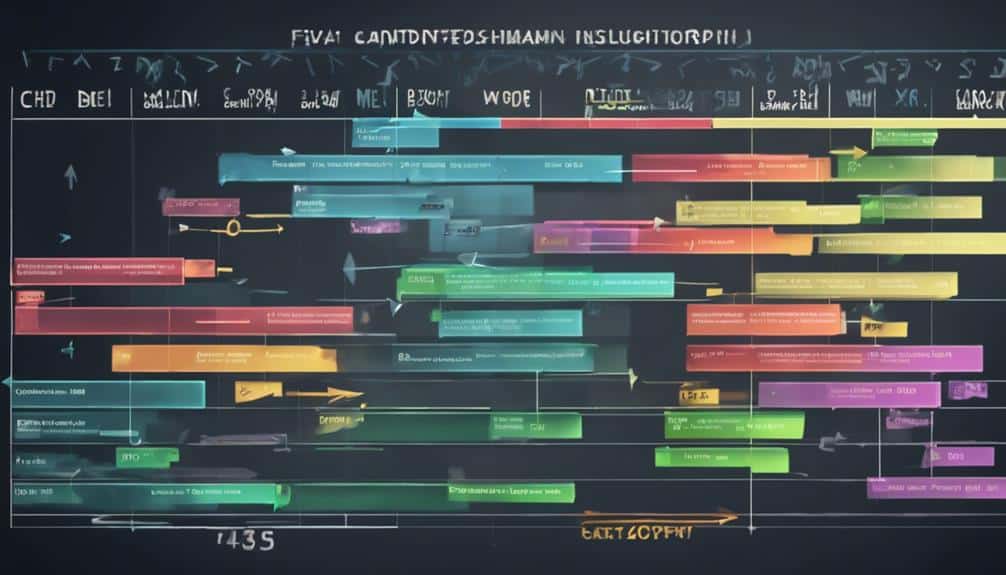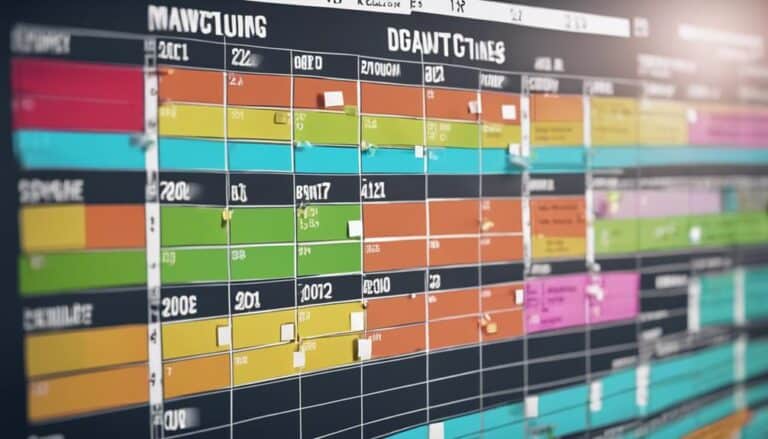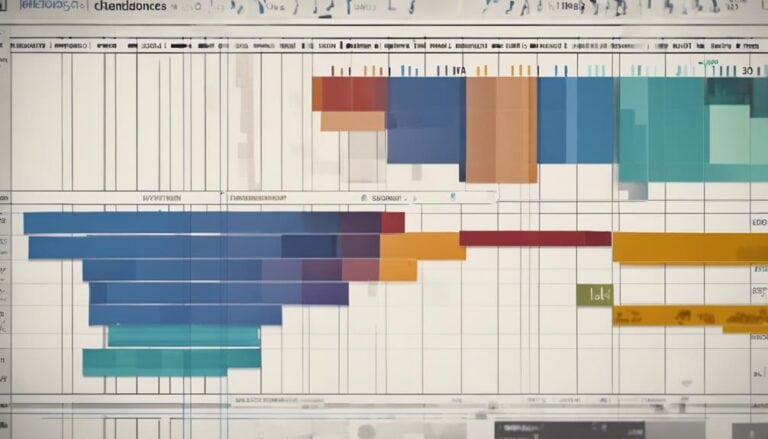Ever felt like you're watching a slow-motion movie while waiting for a construction project to finish? Optimizing project schedules can be a game-changer, and mastering techniques like Critical Path Method, Lean Construction Principles, and Advanced Scheduling Software could be the key.
But hey, there's more! From agile project management to collaboration strategies, the possibilities are endless. Stay tuned to uncover the secrets of efficient scheduling that could revolutionize the way projects are managed and delivered in the construction industry.
Key Takeaways
- Implement Critical Path Method for task prioritization and dependency identification.
- Utilize advanced scheduling software for real-time monitoring and resource management.
- Incorporate contingency planning strategies for risk mitigation and dynamic adjustments.
- Integrate technology for enhanced efficiency, collaboration, and precision in project scheduling.
Critical Path Method Overview
In project management, the Critical Path Method (CPM) efficiently identifies the longest sequence of dependent activities crucial for determining project duration and prioritizing tasks. When applied in construction projects, CPM plays a pivotal role in scheduling and managing tasks effectively. By highlighting the critical path, which comprises activities that directly impact the project timeline, CPM allows project managers to focus on key tasks that influence the overall project completion.
Utilizing specialized software for CPM implementation can streamline the process, providing a clear visual representation of the project timeline and task dependencies.
Effective management of the critical path through CPM enhances project efficiency by ensuring that resources are allocated optimally and potential delays are minimized. This strategic approach to project scheduling fosters improved communication among team members and stakeholders, leading to better coordination and ultimately higher project success rates. By utilizing the insights generated through CPM analysis, project managers can make informed decisions to keep the construction project on track and within the designated timeline.
Lean Construction Principles Application
Transitioning from the Critical Path Method overview, lean construction principles application involves strategically minimizing waste and maximizing value in project delivery through efficient practices and pull planning techniques. Under lean construction, collaborative decision-making and effective communication channels are essential for project success. Visualization tools like network diagrams help optimize project workflows, promoting continuous improvement and innovation in project execution. By embracing lean construction principles, teams can streamline processes, eliminate unnecessary steps, and enhance overall project efficiency.
—
| Lean Construction Principles | Application |
|---|---|
| Efficient Practices | Implementing streamlined processes to reduce waste and increase productivity |
| Pull Planning Techniques | Utilizing pull planning methods to enhance project coordination and scheduling |
| Effective Communication | Establishing clear channels for information flow to ensure project alignment |
—
Advanced Scheduling Software Utilization
Utilize advanced scheduling software to optimize project timelines and enhance transparency in project progress monitoring. By incorporating these tools into your construction project management approach, you can benefit from the following:
- Real-Time Monitoring: Stay updated on project progress instantly, ensuring you're always aware of the latest developments.
- Streamline Scheduling Process: Simplify the complex task of scheduling, allowing for quick adjustments to keep your project on track.
- Project Data Access: Provide stakeholders with easy access to project data, budgets, and timelines, promoting collaboration and informed decision-making.
- Efficient Resource Management: Effectively manage labor and materials, minimizing costs and maximizing resource utilization.
- Reduce Errors and Delays: Mitigate mistakes and delays, paving the way for on-time project delivery and increased productivity.
Embrace the power of advanced scheduling software to revolutionize your construction projects, driving efficiency and success.
Agile Project Management Integration
Embrace the dynamic integration of Agile project management principles to enhance adaptability and innovation in your construction project scheduling approach. Agile project management emphasizes flexibility, iterative planning, and efficient responses to changes in project schedules. By fostering collaboration, feedback, and adaptability among project teams, Agile methodologies ensure that stakeholder needs are met effectively.
The continuous improvement promoted by Agile practices leads to innovative solutions in construction project scheduling processes. Integrating Agile project management principles allows for quick adjustments to evolving project requirements, ensuring that schedules are optimized to meet project objectives. This approach enables project teams to adapt to changes swiftly and deliver high-quality results.
Contingency Planning Strategies
To effectively navigate unforeseen challenges and maintain project timelines, meticulous consideration of potential risks and the formulation of response strategies are essential in contingency planning for construction projects. Critical activities must be identified, and resource allocations should be strategic to ensure smooth project progression.
Time buffers need to be incorporated wisely to account for unexpected delays without compromising the overall schedule integrity. It's crucial to develop dynamic plans that can adapt to evolving circumstances, thus minimizing uncertainties throughout the project lifecycle.
By proactively identifying risks and implementing response strategies, construction teams can effectively mitigate risks and ensure project schedules remain on track. Embracing uncertainty minimization techniques through robust contingency planning not only safeguards against disruptions but also enhances overall project efficiency and success.
- Identify critical activities
- Allocate resources strategically
- Incorporate time buffers wisely
- Develop dynamic plans
- Implement proactive risk mitigation strategies
Collaboration and Communication Techniques
Navigating the complexities of construction projects requires seamless collaboration and effective communication techniques among team members. To achieve this, utilize project management software to streamline communication and foster collaboration.
Implementing BIM platforms enhances coordination by allowing various project stakeholders to share information efficiently. Utilize cloud-based solutions for real-time updates, ensuring all team members have access to the most current project data.
Establish a detailed communication plan to keep everyone informed and aligned with project goals and timelines. Regular project meetings are essential to address communication gaps, resolve issues promptly, and ensure that the project stays on schedule.
Benefits of Construction Scheduling Software
Utilize construction scheduling software to enhance project oversight, boost productivity, and improve stakeholder transparency in construction projects. With scheduling software, you can benefit from:
- Real-time Progress Monitoring: Stay updated on project advancements instantly.
- Increased Productivity: Streamlined processes lead to enhanced efficiency.
- Transparency for Stakeholders: Provide access to crucial project data and timelines.
- Identification of Scheduling Challenges: Quickly spot and resolve issues that may arise.
- Effective Communication and Collaboration: Foster teamwork and ensure project success through improved interaction.
Time Management Best Practices
Enhance your construction project's efficiency and timely completion by implementing effective time management best practices. In construction project management, time management is a critical component for success.
Utilizing tools like Gantt charts and scheduling software can help optimize project schedules by efficiently allocating resources and prioritizing tasks based on dependencies. Strategic sequencing of activities along the critical path is essential to ensure that the project stays on track and meets deadlines.
Incorporating contingency time in the project schedule acts as a buffer against unexpected delays, safeguarding the overall timeline. Regular updates to the project schedule based on real-time data and progress ensure that any changes are accounted for promptly, allowing for efficient scheduling adjustments.
Technology Integration for Efficient Scheduling
Integrating cutting-edge technology into construction project scheduling enhances efficiency and precision through predictive insights and real-time adjustments. By leveraging scheduling software, machine learning, and cloud-based solutions, construction projects can achieve new levels of productivity and accuracy.
Here are five key aspects of technology integration for efficient scheduling:
- Predictive Insights: Utilize advanced software to forecast potential scheduling conflicts and optimize resource allocation.
- Real-Time Adjustments: Implement dynamic scheduling tools that allow for immediate adaptations based on changing project conditions.
- Collaborative Environment: Foster seamless communication channels through scheduling software to enhance coordination among project stakeholders.
- IoT Devices: Integrate IoT devices and sensors to gather real-time data for precise scheduling decisions.
- Communication Channels: Enable remote access features in scheduling software to promote collaboration and streamline project management processes.
Embracing technology in scheduling not only streamlines operations but also paves the way for more agile and efficient construction project management.
Frequently Asked Questions
How Can You Optimize the Project Schedule?
To optimize the project schedule, ensure efficient resource allocation, identify critical path tasks, practice effective time management, manage task dependencies, integrate technology for efficiency, conduct thorough risk assessment, employ clear communication strategies, track progress diligently, engage stakeholders, and maintain schedule flexibility.
How Do You Make a Good Construction Schedule?
To make a good construction schedule, you must consider resource allocation, critical path, activity sequencing, time management, task dependencies, schedule compression, progress tracking, risk assessment, contingency planning, and communication strategies. These elements ensure efficient project planning and execution.
How Can Project Scheduling Be Improved?
To improve project scheduling, focus on resource allocation, time management, critical path, task sequencing, activity prioritization, scheduling software, risk assessment, contingency planning, team coordination, and progress tracking. Enhance efficiency and productivity through strategic planning and collaboration.
What Is Optimization in Construction Project?
To optimize in construction projects, focus on resource allocation, time management, critical path analysis, and efficiency tracking. Prioritize tasks, mitigate risks, control costs, strategize communication, and engage stakeholders. Implement workflow analysis for success.
Conclusion
As you navigate the intricate landscape of construction project schedules, remember that like a skilled conductor leading a symphony, proper planning and execution are key. By incorporating techniques such as the Critical Path Method, Lean Construction principles, and advanced scheduling software, you can orchestrate a harmonious project timeline.
Stay agile, communicate effectively, and embrace technology to ensure a successful construction project delivery. Just like a well-timed melody, a well-executed schedule will lead to a beautiful end result.





